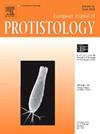Novel taxa of the centrohelid heliozoans (Pterocystida and Panacanthocystida) from agricultural soils
IF 1.6
2区 生物学
Q4 MICROBIOLOGY
引用次数: 0
Abstract
Soil protists play key roles in terrestrial ecosystems, influencing microbial dynamics, nutrient cycling, and plant health. In this study, we describe a new genus and species of centrohelid heliozoans, Tellocystis perplexa gen. et sp. nov. and Raphidocystis akmolaensis sp. nov., isolated from agricultural soil habitats, and characterize two other known cyst-forming centrohelid species from soil. T. perplexa gen. et sp. nov., studied using light and electron microscopy, possesses an unusual spine-scale morphology, featuring a small drop-shaped basal plate and a curved shaft. Phylogenetic analysis of the 18S rRNA gene unexpectedly placed this species within the clade previously referred to as ‘Pinaciophora’, which is nested within Pterista, alongside unpublished clones of ‘Choanocystis perpusilla’ from Franz Josef Land and Southern Transbaikalia. Based on the obtained data, we transferred C. perpusilla to the genus Tellocystis. R. akmolaensis sp. nov. is morphologically similar to R. symmetrica, but differs from it by having smaller cell and plate-scale sizes, and by formation of cyst scales that are distinct from those of its trophic phase. Phylogenetic analysis indicated that this species occupies a deep evolutionary position within Raphidocystidae, basal to R. symmetrica, R. tubifera, R. ambigua, and ‘R. brunii’. This study advances current knowledge of the diversity of soil heterotrophic protists, which play an essential role in regulating microbial populations, and clarifies the intricate taxonomy of some centrohelid heliozoans.
农业土壤中圆心虫的新分类群(翼虫和泛棘虫)
土壤原生生物在陆地生态系统中发挥着关键作用,影响着微生物动力学、养分循环和植物健康。在本研究中,我们描述了从农业土壤生境中分离到的一个新属和新种:Tellocystis perplexa . et sp. 11和Raphidocystis akmolaensis sp. nov.,并对另外两个已知的从土壤中分离到的形成囊状的centrohelids物种进行了表征。使用光镜和电子显微镜研究的T. perplexa gen. et sp. nov.具有不寻常的脊柱鳞片形态,具有小水滴状的基底和弯曲的轴。18S rRNA基因的系统发育分析出乎意料地将该物种置于以前被称为“Pinaciophora”的进化枝中,该进化枝嵌套在Pterista中,与来自Franz Josef Land和南外贝卡拉的“Choanocystis perpusilla”的未发表克隆一起。根据获得的资料,我们将C. perpusilla转移到Tellocystis属。akmolaensis sp. 11 .在形态上与对称r.s ametrica相似,但不同之处在于其细胞和板级尺寸较小,并且形成与营养期不同的囊肿鳞片。系统发育分析表明,该种在Raphidocystidae中处于较深的进化位置,属于对称鼠属、管形鼠属、双歧鼠属和' R。brunii”。本研究进一步提高了对土壤异养原生生物多样性的认识,并澄清了一些中心体日生动物的复杂分类。
本文章由计算机程序翻译,如有差异,请以英文原文为准。
求助全文
约1分钟内获得全文
求助全文
来源期刊

European journal of protistology
生物-微生物学
CiteScore
4.60
自引率
20.70%
发文量
55
审稿时长
14.6 weeks
期刊介绍:
Articles deal with protists, unicellular organisms encountered free-living in various habitats or as parasites or used in basic research or applications. The European Journal of Protistology covers topics such as the structure and systematics of protists, their development, ecology, molecular biology and physiology. Beside publishing original articles the journal offers a forum for announcing scientific meetings. Reviews of recently published books are included as well. With its diversity of topics, the European Journal of Protistology is an essential source of information for every active protistologist and for biologists of various fields.
 求助内容:
求助内容: 应助结果提醒方式:
应助结果提醒方式:


